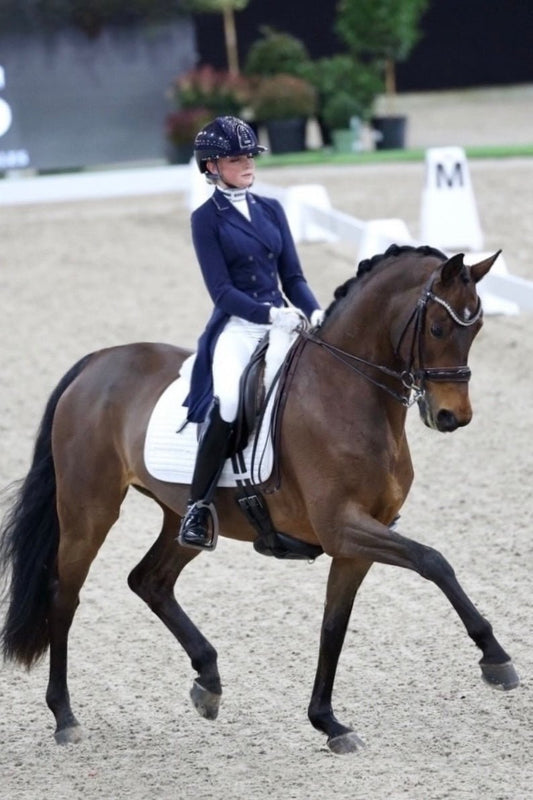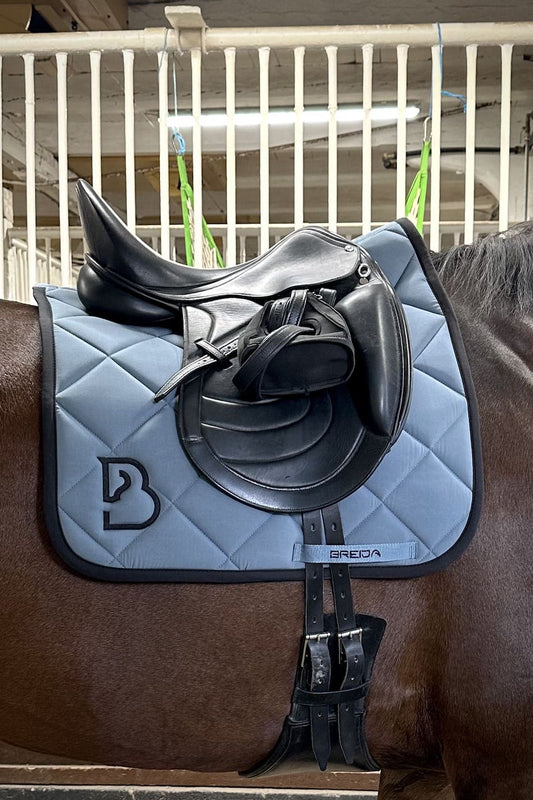Why do you use saddle pads?
The purpose of using a saddle pad under the saddle is partly to equalize the pressure from the saddle and partly to protect the horse from chafing. Therefore, it is important to use a saddle pad with a good fit, with enough padding and with a material on the underside that is as soft and gentle as possible and that conducts heat and moisture away.
What different types of saddle pads do we have and what differentiates them?
We have jump saddle pads that fits jump- and all-round saddles. They are cut more forward than dressage saddle pads. Dressage saddle pads fit dressage saddles and are more straight in the model and reach further down the horse's belly. Our saddle pads are available in sizes for horses and ponies.
How should a saddle pad be placed to avoid chafing and pressure?
The saddle pad must cover the entire saddle and preferably with a small margin, as the edges of the saddle pad can cause chafing if the saddle rests and presses on the edge. If the saddle pad is too thin and limp, it can buckle while riding.
Is it necessary to have a strap on the saddle pad that you attach to the saddle to keep it in place?
It is natural for the saddle to slide back a little after you saddle up, because the saddle also does this before it has been properly adjusted and the saddle girth has been tightened. After that, a good saddle pad stays relatively still for the rest of the training session and no additional buckles or velcro straps are needed. These straps also have a tendency to slip under the saddle and create uneven pressure. If the saddle pad slides behind a lot, it can also be an indication that the saddle does not fit the horse optimally.
Whats important to think of before bying a saddle pad?
For many, the look on the outside of the saddle pad is important and many want to match with other accessories. For us, the inside of the saddle pad is the most important And our primary focus when developing our saddle pad is its function. That the saddle pad fits well on the horse without causing chafing or allergic reactions and that they breathe and absorb moisture are the most important factors in our opinion.
How often should you change the saddle pad?
You need to change / wash the saddle pad when the underside becomes dirty. Since the horse sweats during exercise. On our saddle pad, the dirt is visible because we have a light underside. The dirt is not as clearly visible on saddle pads with a black or dark underside, but the dirt is of course there even if you don't see it.
Since everyone rides differently, some train more intensively and others more calmly, and the horses sweat to different extents depending on their condition and where and when they train, it becomes difficult to say how often the saddle pad should be washed. In short, they need to be washed when they get dirty.
This is how you care for your horse saddle pad
You need to wash the saddle pad when it is dirty because the dirt on the underside of the pad can cause chafing as well as rashes on the horse.
NBelow are tips on simpler measures that can be taken as a preventative measure so that you don't have to machine wash the saddle pad as often.
- Brush the underside of the saddle pad between uses to remove surface dirt and hair.
- You can rinse the inside of the saddle pad with lukewarm water to remove sweat and dirt and then hang to dry.
To machine wash our saddle pad, follow the instructions below.
- Wash at 30 degrees preferably with the delicate wash settings.
- Turn the saddle pad inside out, partly because it is the inside that gets the dirtiest and partly to protect the outside from damage in the washing machine.
- Do not use fabric softener or bleach.
- Hang dry, do not tumble dry.
If the saddle pad has a stain, it is important to remove the stain before washing it in the machine. For example, use bile soap or remove spray.
Varför har man schabrak?
Syftet med att använda schabrak under sadeln är dels för att jämna ut trycket från sadeln och dels för att skydda hästen från skador. Därför är det viktigt att använda ett schabrak med god passform, med tillräckligt mycket fyllning och med ett material på undersidan som är så mjukt och skonsamt som möjligt och som leder bort värme och fukt.
Vilka olika typer av schabrak finns och vad skiljer dem åt?
Vi har hoppschabrak som passar till hopp- och allroundsadlar och som är mer framskurna än vad dressyrschabraket är. Dressyrschabrak passar dressyrsadlar och är mer raka i modellen och når längre ner på hästens mage. Våra schabrak finns i storlek för häst och ponny.
Vad är skillnaden mellan schabrak och Vojlock?
Syftet med schabrak och vojlock är detsamma. Det som skiljer dem åt är designen då man med en vojlock vill följa sadeln design och visa så mycket av hästen som möjligt medan schabraket är mer fyrkantigt och täcker mer av hästen.
Hur ska ett schabrak placeras för att undvika skav och tryck?
Schabraket ska täcka hela sadeln och gärna med lite marginal då kanterna på schabraket kan ge upphov till skav om sadeln ligger an och trycker på kanten. Är schabraket för tunt och sladdrigt kan det korva sig och skapa väck medan man rider.
Är det nödvändigt med kardborreknäppen för att hålla schabraket på plats?
Att schabraket glider bak något efter att man sadlat är naturligt eftersom sadeln också gör det innan den hamnat rätt och sadelgjorden dragits åt ordentligt. Därefter ligger ett bra schabrak relativt stilla resten av träningspasset och ytterligare knäppen eller kardborreband ska inte behövas. Dessa band har även en tendens att glida in under sadeln och skapa ojämnt tryck. Glider schabraket bak väldigt mycket kan det även vara en indikation på att sadeln inte passar hästen optimalt.
Viktigt att tänka på innan köp av ett häst schabrak
För många är utseendet på schabrakets utsida viktigt och man vill matcha med tillbehör och sin egen outfit. För oss är insidan på schabraket viktigast och fokus för oss ligger på schabrakets funktion. Att schabraket ligger bra på hästen utan att ge upphov till skav eller allergiska reaktioner samt att de andas och absorberar fukt är de viktigaste faktorerna enligt oss.
Hur ofta ska man byta schabrak?
Du behöver byta / tvätta schabraket när undersidan blivit smutsig. Eftersom hästen svettas vid träning absorberar schabraket upp svett och smuts. På våra schabrak syns smutsen tydligt eftersom vi har en ljus undersida. Smutsen syns inte lika tydligt på schabrak med svart eller mörk undersida men finns såklart där i samma utsträckning.
Såhär vårdar du ditt häst schabrak
Du behöver tvätta schabraket när det är smutsigt eftersom smutsen på undersidan av schabraket kan ge upphov till skav såväl som utslag på hästen.
Nedan följer tips på enklare åtgärder som kan göras i förebyggande syfte så att du inte behöver maskintvätta schabraket lika ofta.
- Borsta av schabrakets undersida mellan användningarna för att få bort ytligt sittande smuts och hår.
- Du kan skölja av insidan på schabraket med ljummet vatten för att få bort svett och smuts och därefter hänga på tork.
För maskintvätt av våra schabrak, följ anvisningarna nedan.
- Tvättas i 30 grader gärna med inställningarna fintvätt.
- Vänd schabraket ut och in, dels för att det är insidan som blir mest smutsigt och dels för att skydda utsidan från skador i tvättmaskinen.
- Använd inte sköljmedel eller blekmedel.
- Torkas hängande, använd inte torktumlare.
Om schabraket fått en fläck är det viktigt att få bort fläcken innan de maskintvättas. Använd exempelvis galltvål eller ta bort spray.
Warum verwenden Sie Schabracken?
Der Zweck der Verwendung einer Schabracke unter dem Sattel besteht einerseits darin, den Druck vom Sattel auszugleichen, andererseits darin, das Pferd vor Scheuerstellen zu schützen. Daher ist es wichtig, eine Schabracke mit guter Passform, ausreichend Polsterung und einem möglichst weichen und sanften Material auf der Unterseite zu verwenden, das Wärme und Feuchtigkeit ableitet.
Welche verschiedenen Arten von Schabracken gibt es bei uns und was unterscheidet sie?
Wir haben Springschabracken, die zu Spring- und Allroundsätteln passen. Sie sind weiter nach vorne geschnitten als Dressurschabracken. Dressurschabracken passen zu Dressursätteln und sind im Modell gerader und reichen weiter bis zum Pferdebauch. Unsere Schabracken sind in den Größen für Pferde und Ponys erhältlich.
Wie sollte eine Schabracke platziert werden, um Scheuern und Druck zu vermeiden?
Die Schabracke muss den gesamten Sattel bedecken und vorzugsweise mit einem kleinen Rand, da die Kanten der Schabracke zu Scheuerstellen führen können, wenn der Sattel aufliegt und auf die Kante drückt. Ist die Schabracke zu dünn und schlaff, kann sie beim Reiten einknicken.
Ist an der Schabracke ein Riemen erforderlich, den man am Sattel befestigt, um sie an Ort und Stelle zu halten?
Es ist normal, dass der Sattel nach dem Aufsatteln ein wenig nach hinten rutscht, da der Sattel dies auch tut, bevor er richtig eingestellt und der Sattelgurt festgezogen wurde. Danach bleibt eine gute Schabracke für den Rest der Trainingseinheit relativ ruhig und es sind keine zusätzlichen Schnallen oder Klettbänder erforderlich. Außerdem neigen diese Gurte dazu, unter den Sattel zu rutschen und einen ungleichmäßigen Druck zu erzeugen. Wenn die Schabracke stark nach hinten rutscht, kann das auch ein Hinweis darauf sein, dass der Sattel nicht optimal zum Pferd passt.
Was ist vor dem Kauf einer Schabracke wichtig?
Für viele ist die Optik der Außenseite der Schabracke wichtig und viele möchten sie mit anderen Accessoires kombinieren. Für uns ist die Innenseite der Schabracke das Wichtigste und unser Hauptaugenmerk bei der Entwicklung unserer Schabracke liegt auf ihrer Funktion. Dass die Schabracke gut am Pferd sitzt, ohne Scheuern oder allergische Reaktionen hervorzurufen, und dass sie atmungsaktiv ist und Feuchtigkeit aufnimmt, sind unserer Meinung nach die wichtigsten Faktoren.
Wie oft sollten Sie die Schabracke wechseln?
Sie müssen die Schabracke wechseln/waschen, wenn die Unterseite verschmutzt ist. Da das Pferd beim Training schwitzt. Auf unserer Schabracke ist der Schmutz sichtbar, da wir eine helle Unterseite haben. Bei Schabracken mit schwarzer oder dunkler Unterseite ist der Schmutz nicht so deutlich sichtbar, aber der Schmutz ist natürlich auch dann da, wenn man ihn nicht sieht.
Da jeder anders reitet, manche intensiver und andere ruhiger trainieren und die Pferde je nach Kondition und Trainingsort und -zeitpunkt unterschiedlich stark schwitzen, lässt sich nur schwer sagen, wie oft die Schabracke gewaschen werden sollte. Kurz gesagt: Sie müssen gewaschen werden, wenn sie schmutzig werden.
So pflegen Sie Ihre Pferdeschabracke
Sie müssen die Schabracke waschen, wenn sie schmutzig ist, da der Schmutz auf der Unterseite der Schabracke zu Scheuerstellen und Hautausschlägen beim Pferd führen kann.
Im Folgenden finden Sie Tipps zu einfacheren Maßnahmen, die vorbeugend ergriffen werden können, damit Sie die Schabracke nicht so oft in der Maschine waschen müssen.
- Bürsten Sie die Unterseite der Schabracke zwischen den Einsätzen, um oberflächlichen Schmutz und Haare zu entfernen.
- Sie können die Innenseite der Schabracke mit lauwarmem Wasser abspülen, um Schweiß und Schmutz zu entfernen, und sie dann zum Trocknen aufhängen.
Um unsere Schabracke in der Maschine zu waschen, befolgen Sie die nachstehenden Anweisungen.
- Bei 30 Grad waschen, vorzugsweise im Schonwaschgang.
- Drehen Sie die Schabracke um, zum einen, weil die Innenseite am schmutzigsten wird, und zum anderen, um die Außenseite vor Beschädigungen in der Waschmaschine zu schützen.
- Verwenden Sie keinen Weichspüler oder Bleichmittel.
- Zum Trocknen aufhängen, nicht im Wäschetrockner trocknen.
Wenn die Schabracke einen Fleck aufweist, ist es wichtig, den Fleck zu entfernen, bevor Sie sie in der Maschine waschen. Verwenden Sie zum Beispiel Gallenseife oder Entfernungsspray.
















